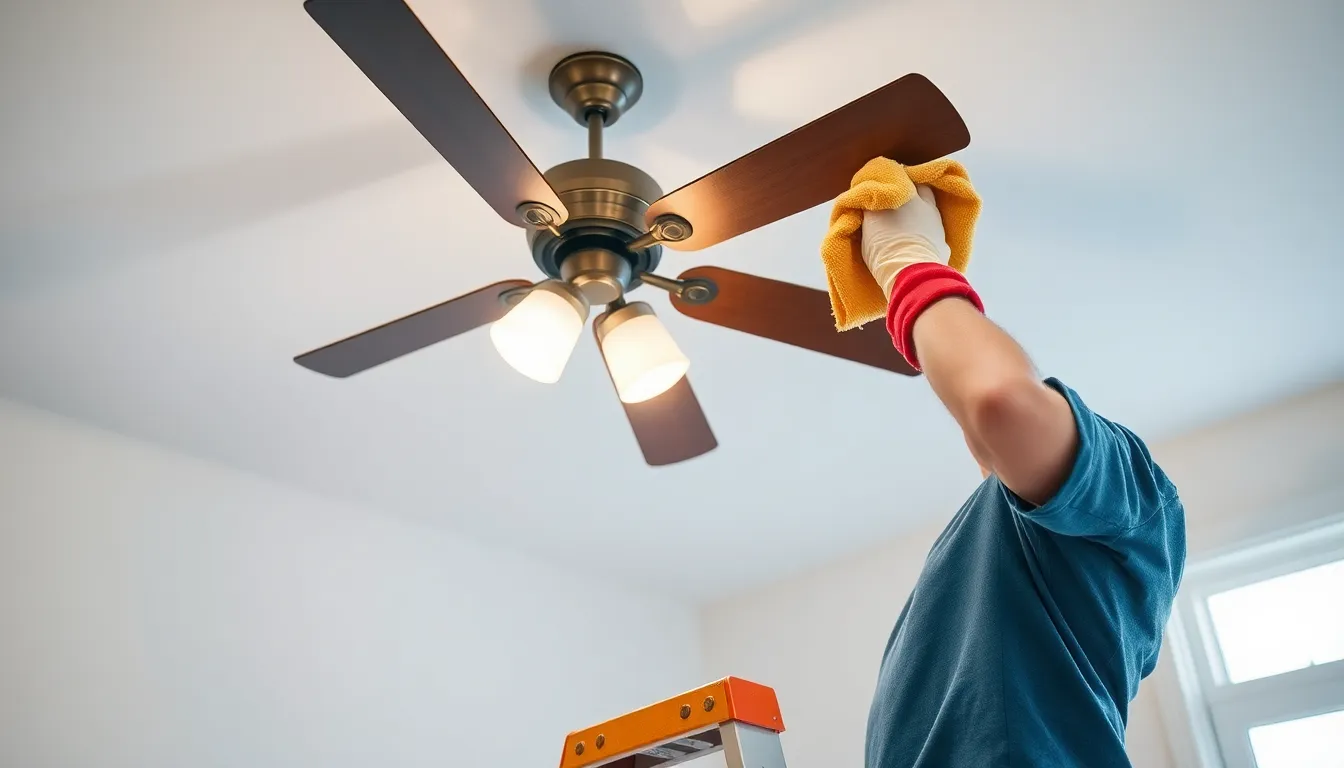Ceiling fans are a popular choice for keeping homes cool and comfortable, but they often collect dust and grime over time. Neglecting this essential maintenance not only affects air quality but can also hinder the fan’s performance. Regular cleaning is crucial to ensure that these fixtures work efficiently and look their best.
Many homeowners overlook the importance of cleaning ceiling fans, assuming that a quick swipe will suffice. However, a thorough cleaning routine can significantly enhance indoor air quality and prolong the life of the fan. With just a few simple steps, anyone can tackle this often-dreaded chore and enjoy a cleaner, fresher living space.
Table of Contents
ToggleImportance Of Cleaning Ceiling Fans
Cleaning ceiling fans significantly improves indoor air quality. Dust and allergens accumulate on fan blades and can circulate throughout a space when the fan operates. Regular cleaning prevents this buildup, which can cause respiratory issues for occupants, especially those with allergies or asthma.
Maintaining the fan’s efficiency is another critical reason for cleaning. Built-up dust can hinder performance, causing the fan to work harder, which increases energy consumption. A clean fan operates smoothly, resulting in lower electricity bills.
Enhancing the fan’s lifespan also relies on routine cleaning. Dust and grime can lead to mechanical wear, reducing the fan’s overall durability. By keeping the fan clean, homeowners prolong its functional lifespan and reduce the need for replacements.
Establishing a thorough cleaning routine promotes a healthier living environment. It includes more than just a quick wipe; it involves carefully dusting blades, cleaning light fixtures, and addressing any buildup in crevices. This comprehensive approach ensures an optimal fan performance while contributing to general cleanliness in the home.
Tools And Materials Needed

Cleaning ceiling fans requires specific tools and materials to achieve optimal results. Using the right supplies ensures a thorough cleaning process, enhancing fan performance and air quality.
Essential Cleaning Supplies
- Microfiber Cloths: Microfiber cloths trap dust and allergens effectively, ensuring a thorough wipe-down of fan blades and surfaces.
- Feather Duster: A feather duster reaches fan blades and tight spaces, making it easier to remove dust without leaving residues.
- Vacuum Cleaner: A vacuum with a brush attachment collects dust from blades and surrounding areas, minimizing airborne particles.
- All-Purpose Cleaner: An all-purpose cleaner helps eliminate grime and sticky residue from fan surfaces for enhanced cleanliness.
- Step Ladder: A stable step ladder allows access to higher ceiling fans, ensuring all areas are reachable during cleaning.
Optional Tools For Efficiency
- Ceiling Fan Dust Covers: These covers, placed over the blades, prevent dust buildup between cleanings, simplifying maintenance.
- Extension Pole: An extension pole with a microfiber attachment increases reach and minimizes the need for ladders, making cleaning safer.
- Spray Bottle: A spray bottle enables precise application of cleaning solution onto cloths, reducing overspray and waste.
- Old Toothbrush: An old toothbrush effectively cleans crevices and hard-to-reach areas, targeting dust accumulation where it’s often overlooked.
- Gloves: Wearing gloves protects hands from dust and cleaning products, promoting hygiene during the cleaning process.
Step-By-Step Guide To Cleaning Ceiling Fans
Cleaning ceiling fans requires a systematic approach to ensure thoroughness and safety. Follow the steps below to achieve optimal results.
Preparing The Area
Preparing the area ensures an efficient cleaning process. Clear the surrounding furniture and cover surfaces with a drop cloth or old sheets to catch falling dust. Ensure the fan is turned off and wait for the blades to stop completely. Set up a stable step ladder if necessary for safe access to higher fans.
Removing Dust And Debris
Removing dust and debris involves initial steps to reduce buildup. Use a microfiber cloth or a feather duster to trap dust on the blades and motor. Alternate between the duster and a vacuum cleaner with a brush attachment to collect loose particles on the fan and nearby areas. This step significantly reduces allergens and enhances the overall cleanliness of the living space.
Cleaning The Blades
Cleaning the blades requires specific attention to detail. Spray an all-purpose cleaner on a microfiber cloth rather than directly on the blades to prevent excess liquid. Wipe each blade thoroughly, using a gentle back-and-forth motion to eliminate grime. For stubborn buildup, use an old toothbrush to scrub crevices and edges where dirt accumulates.
Finishing Touches
Finishing touches enhance the overall effectiveness of the cleaning process. Recheck the motor housing and light fixtures, cleaning those areas with an all-purpose cleaner and cloth. Once finished, dispose of any dust and debris from the drop cloth. Inspect the fan for any visible dust or spots, ensuring complete cleanliness before reassembling any fixtures.
Tips For Maintaining Clean Ceiling Fans
Regular maintenance ensures ceiling fans operate efficiently and contribute to indoor air quality. Adhering to a consistent cleaning schedule and implementing preventive measures enhances longevity and performance.
Frequency Of Cleaning
Cleaning ceiling fans every month is recommended to prevent dust accumulation. Seasonal cleaning before summer use guarantees optimal airflow. Those with pets or allergies may require more frequent cleanings, potentially every two weeks, to effectively minimize allergens. Consistent cleaning significantly lessens the amount of buildup and sustains the fan’s efficiency.
Best Practices For Preventive Maintenance
Implementing preventive maintenance practices keeps ceiling fans in top condition.
- Regular Inspections: Inspect fans monthly for loose screws, dirt buildup, or signs of wear.
- Dusting Often: Use a microfiber cloth weekly to dust blades and minimize accumulation.
- Check Motor and Bearings: Ensure the motor runs smoothly and lubricate bearings if necessary.
- Change Air Filters: For fans integrated with HVAC systems, replace filters as per manufacturer guidelines to maintain air quality.
- Avoid Overloading: Ensure the fan isn’t overloaded with dust by placing furniture and decor away from the fan’s reach.
Following these practices supports a cleaner and more efficient ceiling fan, contributing to an overall healthier indoor environment.
Maintaining clean ceiling fans is essential for both comfort and health. Regular cleaning not only enhances air quality but also maximizes fan efficiency and prolongs its lifespan. By establishing a consistent cleaning routine and using the right tools, homeowners can effectively reduce dust and allergens in their living spaces.
Incorporating these practices into home maintenance will lead to a more pleasant environment and lower energy costs. With a little effort and attention, keeping ceiling fans clean becomes a straightforward task that pays off in improved air quality and fan performance. Embracing this routine ensures a healthier home for everyone.









